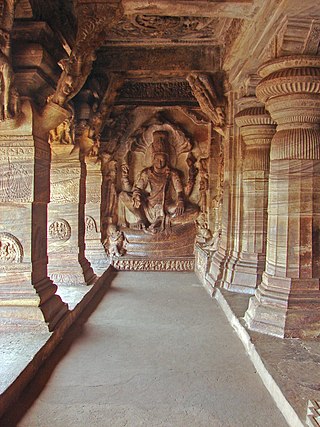
Sculpture is the branch of the visual arts that operates in three dimensions. Sculpture is the three-dimensional art work which is physically presented in the dimensions of height, width and depth. It is one of the plastic arts. Durable sculptural processes originally used carving and modelling, in stone, metal, ceramics, wood and other materials but, since Modernism, there has been an almost complete freedom of materials and process. A wide variety of materials may be worked by removal such as carving, assembled by welding or modelling, or moulded or cast.

A missionary is a member of a religious group which is sent into an area in order to promote its faith or provide services to people, such as education, literacy, social justice, health care, and economic development.
Apologetics is the religious discipline of defending religious doctrines through systematic argumentation and discourse. Early Christian writers who defended their beliefs against critics and recommended their faith to outsiders were called Christian apologists. In 21st-century usage, apologetics is often identified with debates over religion and theology.

Ellora is a UNESCO World Heritage Site located in the Chhatrapati Sambhaji Nagar district of Maharashtra, India. It is one of the largest rock-cut Hindu temple cave complexes in the world, with artwork dating from the period 600–1000 CE. Cave 16 features the largest single monolithic rock excavation in the world, the Kailash temple, a chariot-shaped monument dedicated to the god Shiva. The Kailash temple excavation also features sculptures depicting various Hindu deities as well as relief panels summarizing the two major Hindu epics.

The American College, often referred to as American College, is one of the oldest colleges in India, located in Madurai, Tamil Nadu. It was founded in 1881 by American Christian missionaries. The red-brick buildings, in the Saracenic style, blend with the natural surroundings constructed by British architect Henry Irwin. Century-old buildings Main Hall, James Hall and Washburn Hall show the heritage of the college.

The culture of Indonesia has been shaped by long interaction between original indigenous customs and multiple foreign influences. Indonesia is centrally-located along ancient trading routes between the Far East, South Asia and the Middle East, resulting in many cultural practices being strongly influenced by a multitude of religions, including Buddhism, Christianity, Confucianism, Hinduism, and Islam, all strong in the major trading cities. The result is a complex cultural mixture, often different from the original indigenous cultures.

Hinduism is a minority religion in South America, which is followed by even less than 1% of the total continent's population. Hinduism is found in several countries, but is strongest in the Indo-Caribbean populations of Guyana and Suriname. There are about 320,000 Hindus in South America, chiefly the descendants of Indian indentured laborers in the Guianas. There are about 185,000 Hindus in Guyana, 120,000 in Suriname, and some others in French Guiana. In Guyana and Suriname, Hindus form the second largest religion and in some regions and districts, Hindus form the majority. Though in recent times, due to influence of Hindu culture the number of Hindus converts have increased in other countries in South America, including Brazil, Argentina, Venezuela and others.

Robert Caldwell was a missionary for London Missionary Society. He arrived in India at age 24, and studied the local language to spread the word of the Bible in a vernacular language, studies that led him to author a text on comparative grammar of the South Indian languages. In his book, Caldwell proposed that there are Dravidian words in the Hebrew of the Old Testament, the archaic Greek language, and the places named by Ptolemy.

The Salar Jung Museum is an art museum located at Dar-ul-Shifa, on the southern bank of the Musi River in the city of Hyderabad, Telangana, India. It is one of the notable National Museums of India. Originally a private art collection of the Salar Jung family, it was endowed to the nation after the death of Salar Jung III. It was inaugurated on 16 December 1951.
The history of the Jews in India dates back to antiquity. Judaism was one of the first foreign religions to arrive in India in recorded history. Indian Jews are a small religious minority who have lived in India since ancient times. They have experienced very sparse instances of anti-Semitism from the local non-Jewish majority.

Christianity is India's third-largest religion with about 27.8 million adherents, making up 2.3 percent of the population as of the 2011 census. The written records of the Saint Thomas Christians state that Christianity was introduced in the Indian subcontinent by Thomas the Apostle, who sailed to the Malabar region in the present-day Kerala state in 52 AD.

Indian art consists of a variety of art forms, including painting, sculpture, pottery, and textile arts such as woven silk. Geographically, it spans the entire Indian subcontinent, including what is now India, Pakistan, Bangladesh, Sri Lanka, Nepal, and at times eastern Afghanistan. A strong sense of design is characteristic of Indian art and can be observed in its modern and traditional forms.

Buddhism has a long history in Indonesia, and is recognized as one of the six recognized religions in Indonesia, along with Islam, Christianity, Hinduism and Confucianism. According to the 2018 national census roughly 0.8% of the total citizens of Indonesia were Buddhists, and numbered around 2 million. Most Buddhists are concentrated in Jakarta, Riau, Riau Islands, Bangka Belitung, North Sumatra, and West Kalimantan. These totals, however, are probably inflated, as practitioners of Taoism and Chinese folk religion, which are not considered official religions of Indonesia, likely declared themselves as Buddhists on the most recent census. Today, the majority of Buddhists in Indonesia are Chinese, however small communities of native Buddhists also exist.

The Badami cave temples are a complex of Hindu and Jain cave temples located in Badami, a town in the Bagalkot district in northern part of Karnataka, India. The caves are important examples of Indian rock-cut architecture, especially Badami Chalukya architecture, and the earliest date from the 6th century. Badami is a modern name and was previously known as Vataapinagara, the capital of the early Chalukya dynasty, which ruled much of Karnataka from the 6th to the 8th century. Badami is situated on the west bank of a man-made lake ringed by an earthen wall with stone steps; it is surrounded on the north and south by forts built in later times. These caves were discovered by Stella Kramrisch in 1924.

Indian rock-cut architecture is more various and found in greater abundance in that country than any other form of rock-cut architecture around the world. Rock-cut architecture is the practice of creating a structure by carving it out of solid natural rock. Rock that is not part of the structure is removed until the only rock left makes up the architectural elements of the excavated interior. Indian rock-cut architecture is mostly religious in nature.

Hinduism is a minority faith in Zimbabwe.

Overseas Indians, officially Non-Resident Indians (NRIs) and Overseas Citizens of India (OCIs) are Indians who live outside of the Republic of India. According to the Government of India, Non-Resident Indians are citizens of India who are not living in the country, while the term People of Indian Origin (PIOs) are people of Indian birth or ancestry who are not citizens of India, but are citizens of other nations and may additionally have Overseas Citizenship of India (OCI), with those having the OCI status known as Overseas Citizens of India. According to a Ministry of External Affairs report, there are 32 million NRIs and OCIs residing outside India and overseas Indians comprise the world's largest overseas diaspora. Every year 2.5 million Indians migrate overseas, which is the highest annual number of migrants in the world.

The ancient and refined traditional culture of Kathmandu, for that matter in the whole of Nepal, is an uninterrupted and exceptional meeting of the Hindu and Buddhist ethos practiced by its highly religious people. It has also embraced in its fold the cultural diversity provided by the other religions such as Kirat, Jainism, Islam and Christianity.

Swaminarayan Akshardham in Robbinsville, New Jersey, is a Hindu mandir (temple) complex. The BAPS Shri Swaminarayan Mandir, one component of the campus, was inaugurated and opened to the public on August 10, 2014 as the world’s largest Hindu temple outside India. The Mandir is geographically situated at the heart of the U.S. Northeast megalopolis and with relative proximity to Newark International Airport, which handles nonstop flights to India.

It is quite difficult to define Indonesian art, since the country is immensely diverse. The sprawling archipelago nation consists of 17.000 islands. Around 922 of those permanently inhabited, by over 1,300 ethnic groups, which speak more than 700 living languages.



















